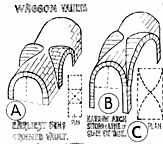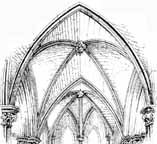Introduction
Roman and Romanesque vaulting consisted entirely in the design of the vaulting planes or surfaces without reference to their meeting lines or groins, whereas mediaeval vaulting consisted in profiling the groins which were erected first and supporting the vaulting surfaces whech were made to adapt themselves to them.
The problem for the mediaeval architects was to vault, in stone, the nave of a church of the basilican type. and at the same time to provide to provide for the lighting of the building by means of clerestory windows in the nave walls above the aisle roofs. The church was thus crowned with a fire-resisting covering over which a wooden roof was placed in order to protect it from the weather.
The evolution of vaulting in England, as on the Continent, involved the solution of a group of constructive problems. Thus it was in connection with the necessity for counteracting the thrust of the nave vaults brought down on piers that the greater part of the evolution of the constructive side of the style took place. The following may be taken as the main features of vaulting in each period:
Norman

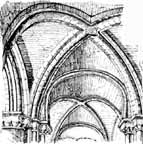
Left: Diagonal segmental ribs in Peterborough Cathedral.
Right: Diagram of diagonal segmental ribs. [Click on the thumbnails for larger images.]
The Roman system was in vogue up to the twelfth century, but the introduction of transverse and diagonal ribs in this period rendered temporary centering necessary for these. In England the raising of the diagonal rib, which produced the domical vault employed on the Continent, seems to have been but little used, and the method was either (a) to make diagonal ribs segmental, as in the aisles at Peterborough Cathedral; or (b) to make the diagonal ribs semicircular and stilt the springing of the transverse and longitudinal ribs.
Left: Sexpartite (six part) vaulting, Abbaye-aux-Honnne at Caen.
Right: Groined, stilted, and pointed cross vaulting in square bays.
A great advance was made by the introduction of the pointed arch, which was used firstly for the transverse and wall ribs only, the diagonal ribs (i.e. those with the longest span) remaining semi- circular. Norman vaulting was either cylindrical or barrel vaulting, as at the Tower of London; groined cross vaulting in square bays; other shapes in which the narrower vaulting arches were stilted, or, in the later period, were pointed; Sexpartite (six part) vaulting as in the choir at Canterbury Cathedral, rebuilt by William of Sens in A.D. 1174..Early English (Thirteenth Century)
Early English groined vaulting at Salisbury.
The pointed arch became permanently established, surmounting all the difficulties of difference in span, and enabling vaults of varying sizes to intersect without stilting or other contrivances. The cells, also known as "severies" or "infilling" were quite subordinate to the ribs and were of clunch or light stone in thin beds, resting upon the back of the ribs. These severies were of arched form, but often had winding surfaces, and were constructed so that their pressure was directed towards the piers and not the wall rib. The "ploughshare twist," so called from its resemblance to a ploughshare, was produced by stilting or raising the springing of the wall rib, when forming the window arch bordering on a vaulting compartment, above that of the diagonal and transverse ribs. This was a common arrangement, and was necessary in order to obtain greater height for the clerestory windows.The geometry of the Gothic system was a rough use of mathematical truths in which beauty was sought for, and not a strict regard for the exactitude of scientific demonstration. The curvature of the ribs was obtained from arcs struck from one or more centres, and designed without reference to the curvature of adjoining ones, as is seen in the setting out of Gothic vaulting compartment. In this lies the whole difference between the Roman and mediaeval systems, for in the former the vaulting surface is everywhere level in a direction parallel to the axis of the vault, and any horizontal section of a spandrel or meeting of two cross vaults would be a rectangle. In the ribbed Gothic vault, however, the plan thus formed would have as many angles as ribs, varying according to the curve of the latter.
The plain four-part (quadripartite) ribbed vault, primarily constructed as a skeleton framework of diagonal and transverse ribs, was chiefly used in this period, as in the naves of Durham, Salisbury, and Gloucester, and the aisles of Peterborough.
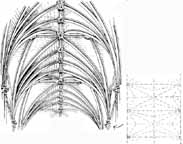
Early English groined vaulting with intermediate ribs, Westminster Abbey.
Later in the century intermediate ribs known as tiercerons, were introduced between the transverse and diagonal ribs as in the vaulting of the nave of Westminster Abbey, and were especially needed to strengthen the vaulting surfaces by decreasing the space between the ribs. In such cases ridge ribs were introduced in order to take the thrust of the tiercerons wdiich abut at their summit at an angle, and would have a tendency to fall towards the centre of the compartment unless resisted by the ridge rib. In continental examples the ridge rib is often not continuous, but only extends to the last pair of arches which abut against it obliquely. Ridge ribs are generally horizontnal in England and arched on the Continent, the "infilling " or "severy" having its courses meeting at the ridge in zigzag lines as in the nave of Westminster Abbey, and the naves and choirs of Lincoln, Exeter and Lichfield Cathedral, and as found in the churches of South-West France. A wall-rib, called a "formeset," because forming a boundary for each compartment, was also introduced.
Decorated (Fourteenth Century)
Left: Lierne Vault, Bristol Cathedral. Right: Lierne Stellar Vault, St.Mary Radcliffe
During this period of the Decorated Style there was an increase and elaboration of intermediate ribs (tiercerons), ridge ribs, and a new set of ribs known as Lierne ribs, from the French lien — to bind or hold. The name "lierne" is applied to any rib, except a ridge rib, not springing from an abacus.In the early plain-ribbed vaulting each rib marked a groin, i.e., a change in the direction of the vaulting surface, but lierne ribs were merely ribs lying in a vaulting surface, their form being determined independently of such surface, which, however, regulated their curvature. These liernes, by their number and disposition, often give an elaborate or intricate appearance to a really simple vault, and in consequence of the star-shaped pattern produced by the plan of such vaults, it is often called " Stellar" vaulting. Examples of this type exist in the choirs of Gloucester (A.D. 1337-77), Wells, Ely, Tewkesbury Abbey nave, Bristol, and the vaulting of Winchester Cathedral, as carried out (A.D. 1390) by William of Wykeham.vaulting of this period therefore consisted of transverse, diagonal, intermediate, ridge and lierne ribs — in fact, a vault of numerous ribs, and of panels which became smaller and smaller until a single stone frequently spanned the space from rib to rib, known as " rib and panel " vaulting.
Perpendicular (Fifteenth Century)
The complicated "stellar" vaulting of the late fourteenth and early fifteenth centuries (No. 112 P, o) led, by a succession of trials and phases, to a peculiarly English type of vaulting in this century known as fan, palm or conoidal vaulting, in which the main ribs, forming equal angles with each other and being all the same curvdture, are formed on the surface of an inverted concave cone, and connected at different heights by horizontal lierne ribs.
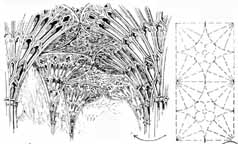
Fan Vaulting, Gloucester Cathedral.
The development was somewhat as follows: — In the thirteenth century the form of an inverted four-sided hollow rectangular pyramid was the shape given to the vault. In the fourteenth century the masons converted this shape, by the introduction of more ribs, into a polygonal (hexagonal) pyramid, as in S. Sepulchre, Holborn, and elsewhere. In the fifteenth century the setting out of the vault was much simplified by the introduction of what is generally known as "Fan " vaulting, described above).
Owing to the reduction of the size of panels, due to the increase in the number of the ribs, a return was made to the Roman method of vault construction, for in fan vaulting the whole vault was often constructed in jointed masonry, the panels being sunk in the soffit of the stone forming the vault instead of being separate stones resting on the backs of the ribs. The solid method seems to have been adopted first in the crown of the vaults where the ribs were most numerous. In some "perpendicular" vaults the two Systems are found, as at King's College Chapel, Cambridge; in others, as Henry VII.'s Chapel, Westminster, the whole vault is of jointed masonry.
The difficulty of supporting the flat lozenge-shaped space in the top portion of the vault surrounded by the upper boundaries of the hollow cones was comparatively easy in the cloisters, where this type of vaulting was first introduced, because the vaulting spaces to be roofed were square or nearly so, but when it was attempted to apply it to the bays of the nave, which were generally twice as long transversely as longitudinally, difficulties occurred. In King's College Chapel (A.D. 1513) the conoid was continued to the centre, but the sides were cut off, thus forming an awkward junction transversely. In the nave of Henry VII.'s Chapel pendants supported by internal arches were placed away from the walls and the conoids supported on these, thus reducing the size of the flat central space, and changing it from an oblong to a square on plan. At Oxford Cathedral a somewhat similar method was adopted, the pendants also placed some distance from the wall, being supported on an upper arch, and a polygonal form of ribs adhered to.
Fan vaulting is confined to England, and other examples beyond those already mentioned are in the Divinity Schools, Oxford; Trinity Church, Ely; Gloucester Cathedral (see illustration above); S. George's Chapel, Windsor; the retro-choir, Peterborough, and elsewhere.
The depressed fon-centred arch is typical of the architecture of the Tudor period, although it seems to have been used in the vaulting of earlier churches. It is not found out of England, and appears to have been first used largely in fan vaulting, to which the reason for its adoption is held to be due. For example, if the diagonal rib is to be a pointed two-centred arch, each portion must obviously be less than a quadrant, and the transverse and wall ribs, being shorter, must be con- siderably less than quadrants, especially if the compartment is oblong, and this would make the window arch in the nave wall of acute lancet form ; but the window arch was made equilateral or even less in height compared to its span in this period, and so the segments of a diagonal arch of two centres preserving the same curvature would not meet at their summit without becoming horizontal or possibly bending downwards to each other. To obviate this the transverse and diagonal ribs in an oblong com- partment were sometimes made as four-centred arches, all the ribs starting with the same curvature, but at a certain height the portions above this level were drawn with a longer radius in order that they might meet the ribs from the opposite side of the vault at the required height. These four-centred arches were afterwards applied to other parts of the buildings in England, as in arches to doors and windows, and tracery work in panelling, possibly with a desire to harmonize with the important superstructure of vaulting.
"Pendant" vaulting is a later form often used in connection with fan vaulting, in which pendants as elongated voussoirs are dropped from a constructive pointed arch, concealed above the vaulting, and form abutments to support the pendant conoids. Henry VII's Chapel and Oxford Cathedral are examples of this method of vaulting. Examples of "pendant" but not of "fan" vaulting are frequent in the Flamboyant period (fifteenth century) in France, as at Caudebec, and other places.
Bosses. — The bosses, or ornamentd keystones, which form such decorative features in Gothic vaulting, were a constructive necessity, primarily used to cover the awkward junction of the various ribs meeting at all angles, in order that the awkward mitres of the rib mouldings might be hidden behind the ornament of the boss.References
Fletcher, Banister, and Banister F. Fletcher. A History of Architecture on the Comparative Method for the Student, Craftsman, and Amateur. 5th ed. London: B. T. Batsford, 1905. Pp. 335-41.
Last modified 30 August 2007
